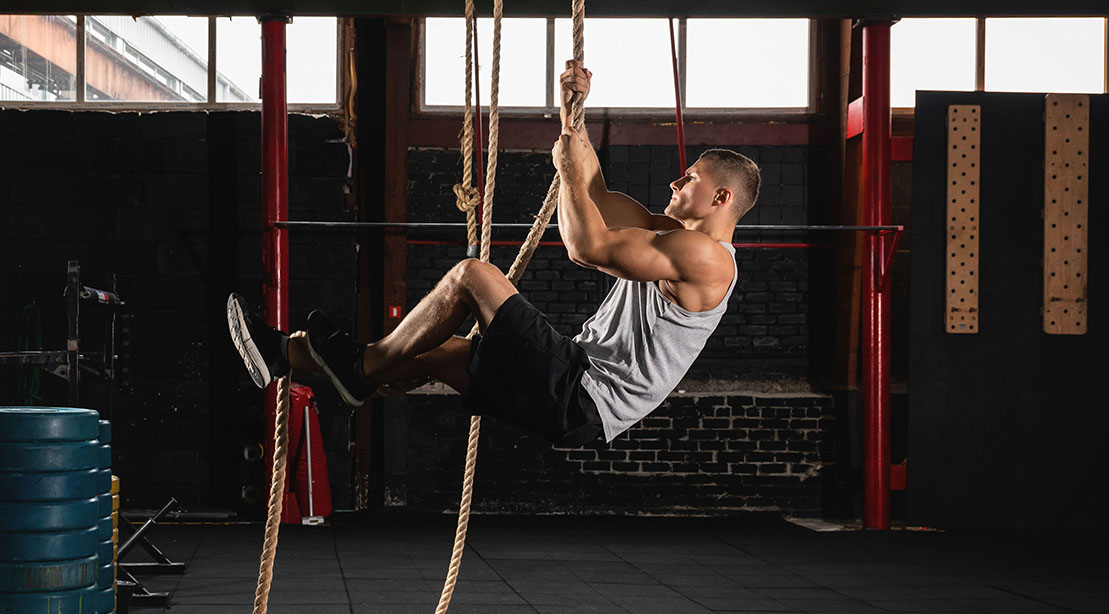While some make rope climbing look easy, you can rest assured they didn’t breeze up the rope when first starting out. Climbing rope is an intense workout that takes a specific technique (and lots of practice) to nail it.
But what about the kids in high school gym class that made climbing rope look like a walk in the park? Chances are, those kids spent lots of time in a setting where climbing rope was practiced. Same with regular CrossFit goers and elite athletes—lots of practice, so don’t fret if you think it’s too hard for you to do.
“Climbing a rope is not just for the military or elite athletes,” says Joshua Fitchitt, senior director of fitness services at PRO Club in Bellevue, WA. It’s for anyone looking for a fun exercise and for those wishing to add variety to their workout routines.
Here, Fitchitt provides step-by-step instructions that will teach you how to successfully climb a rope one technique at a time!

Benefits of Rope Climbing
If you ever attempted to climb a rope you know it makes more than grip strength to muster yourself upward; it’s more like a full body workout. “Efficient rope climbing uses muscles in the lower body (quadriceps, hamstrings, and gastrocnemius),” says Fitchitt. And it doesn’t stop there.
Climbing also uses the muscles involved with your grip and the muscles in your arms. Not to mention the back and core.
“Rope climbing can significantly enhance your overall fitness and physical capabilities,” says Fitchitt, and can be added into any workout routine to help add a layer of whole-body conditioning.
“It is a fun and challenging exercise that develops strength, improves grip, and boosts coordination; When you can climb a rope, you feel empowered,” he adds.
With that, the next time you attempt the rope, hold onto these two techniques that will help you get to the top. Let’s Climb!
Before You Begin, Grab These Rope Climbing Essential Items
- Gym Chalk: Made from the same magnesium carbonate formula that rock climbers trust when their lives depend on a firm grip, this chalk quickly absorbs moisture from your hands keeping you safe on your climb.
Buy It: Rogue Gym Chalk – Magnesium Carbonate | Rogue Fitness - Liquid Grip: If you don’t want to keep chalking up, Liquid grip calls for one application while providing a moisture-free hold.
Buy It: Liquid Grip – Weightlifting Accessory | Rogue Fitness - Climbing Ropes*: When your gym doesn’t provide a rope, this selection will keep you safe on your ascension by offering the same reliable grip and durability that’s made the classic manila rope a staple of military bases and shipyards for decades.
Buy It: Rogue Manila Climbing Ropes – Braided Eyelet – American Made | Rogue Fitness
*Safety Tip: Be sure to have a professional show you how to safely and properly secure your rope to prevent falls. - Climbing Shoes: A reliable pair of training shoes, such as the Reebok Nano Classic, will help keep your feet comfortable and light as you climb, this shoe is equipped with floatride energy foam providing lightweight and responsive cushioning.
Buy It: Nano Classic Shoes Black | Reebok
Top 6 Tips to Climbing a Rope Faster and Easier
- Start by sitting on top of a box and practicing the J-hook to stand or Spanish Wrap to Stand.
- It’s important that you can maintain the pressure on the rope before you stand up.
- A trick to make climbing a rope easier is to start with a jump off the floor. This will place you higher up on the rope and make it faster to get up the rope. It also helps to wear long socks, a shin protector, or a knee sleeve on your shin to prevent burns from rope friction.
- A good pair of cross-trainers work well for footwear. Running shoes can often get shredded when people are first learning rope climbs.
- When coming down the rope use your feet to slow the descent.
- Don’t hold the rope like it is a fire pole and slide down (this will cause a rope burn on your hands).
With practice and the right techniques, you’ll go from the bottom to the top rope before you know it!
Step-by-Step Rope Climbing Techniques
Fitchitt explains there are two techniques that people generally use when first learning how to climb a rope: the J-Hook Technique and the Spanish Warp Technique.



Comments are closed.